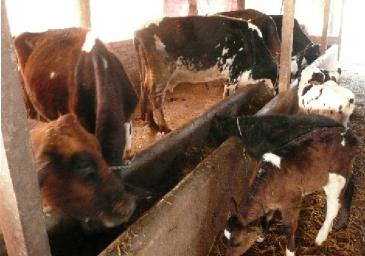Submitted by Gidi on

In the beginning of January I was in Nepal for PUM Nederlandse senioren experts to advise and extended dairy farm. In Nepal about 65 percent of the households are farming smallholder farms and they don’t produce enough for the 28 million inhabitants. Nepal imports all kind of food, from vegetables till milk and meat from sheep and goat. The import of milk from India is halve a million litres a day. Small holder farmers have one or two cows or buffaloes and produce enough for their own use and maybe a little bit for he neighbours. Nepal is one of the world’s poorest countries but nobody is hungry, I was assured. I spend two weeks on a cow farm in the Terai area, the fertile and flat area between India and the Himalaya mountains. A strip of land from 1500 km long and about 45 km wide. Farming is traditional, small plots, human and animal labour and very few tractors. Paddy rice, grain, bit of clover and grass from the roadside or from the forest to feed the cattle or the buffaloes. Milk consumption increases and they want to produce more milk and be self-sufficient.
The farm I visited started 2 years ago and caused a snowball effect: In the nearby villages 43 extended farms were developed and business was booming. It seemed that they jump without any plan and without any knowledge about farming into the business, got money from banks or other financers and started an extended farm, to show that they can do it. At least they expected it to managing it as a factory or an office: everything controlled. And now on those extended farms animals lack quality feed and owners are losing money. Farmers lack knowledge about feeding and quality feed. A report from the Nepalese ministry of agriculture states that the country lacks 50 % of the dry matter animals need, and that is including the dry mater harvested in forests and between bushes. A remarkable sentence in the report was that the animals lack feed because of humans started eating their feed (we think that animals should not compete with humans). The extended farms lack grassland: there is land available but with the traditional means of harvesting, cut it with a knife and carry it home, it is impossible to harvest grass for 25 cows and 25 heifers every day, not even with very cheap labour. The cows are tethered indoors, in closed stables without bedding material and get some green roughage, rice straw and a lot of by-products of rice and mustard. The animals show that they don’t get enough: they are very skinny, the production is low, they don’t want the bull, as they express it, and the dry period is 6 – 8 month. Heifers two years of age are not mated because they are not cycling. That all creates a cost price of the milk that is about double the price they get for the milk from the dairy.
The solution is balance between the number of adapted animals and the availability of quality roughage. Besides that education and sharing basic knowledge about animals, feeding, grass and other crops and recordkeeping would help development in a more modern way of farming because the traditional methods don’t work on an extended farm. To develop you need frontrunners taking risks, jumping without knowing where to land, but now they risk a very rough landing. Let’s hope that they find prestige in having a smaller, well managed farm with healthy and productive animals.
- Gidi's blog
- Log in to post comments
